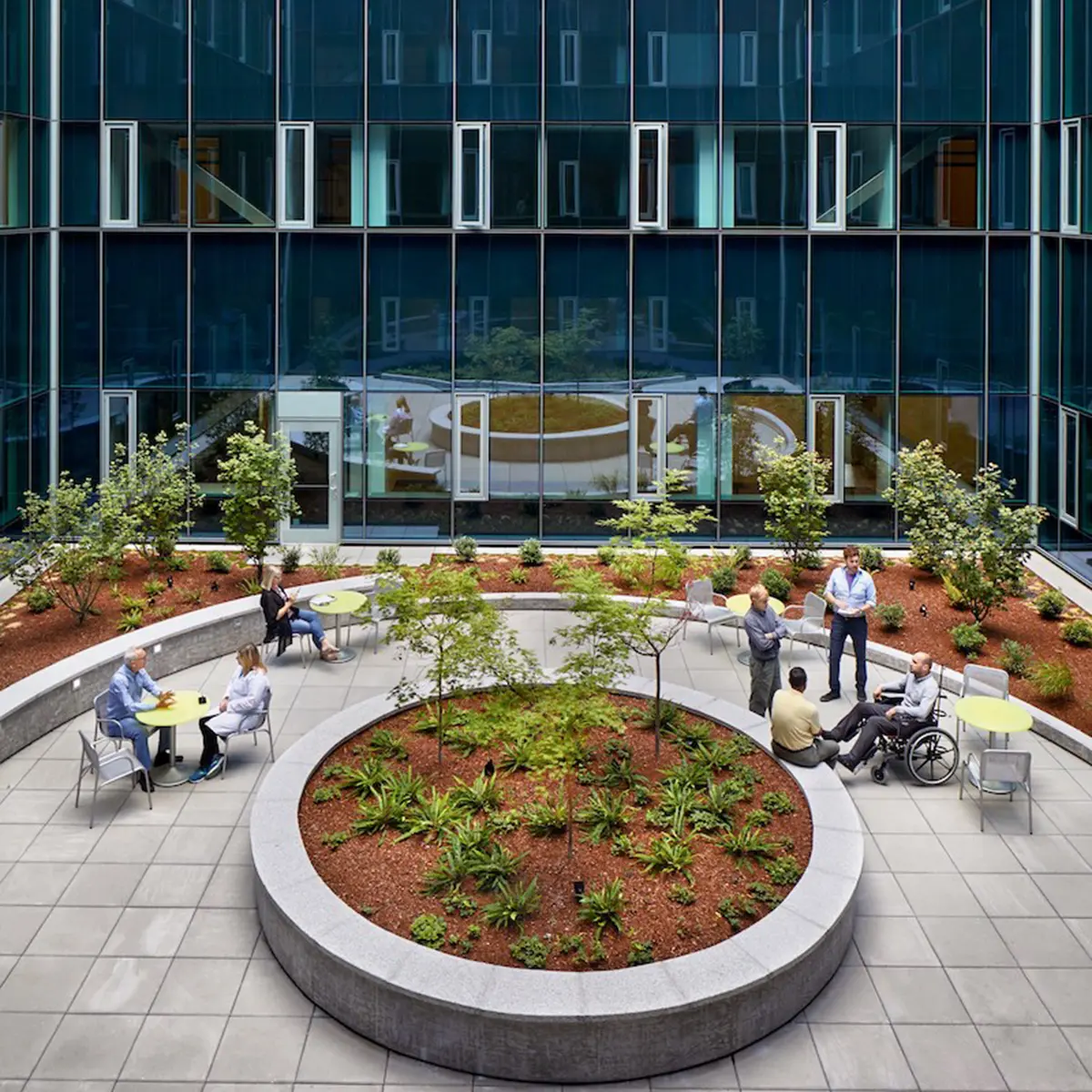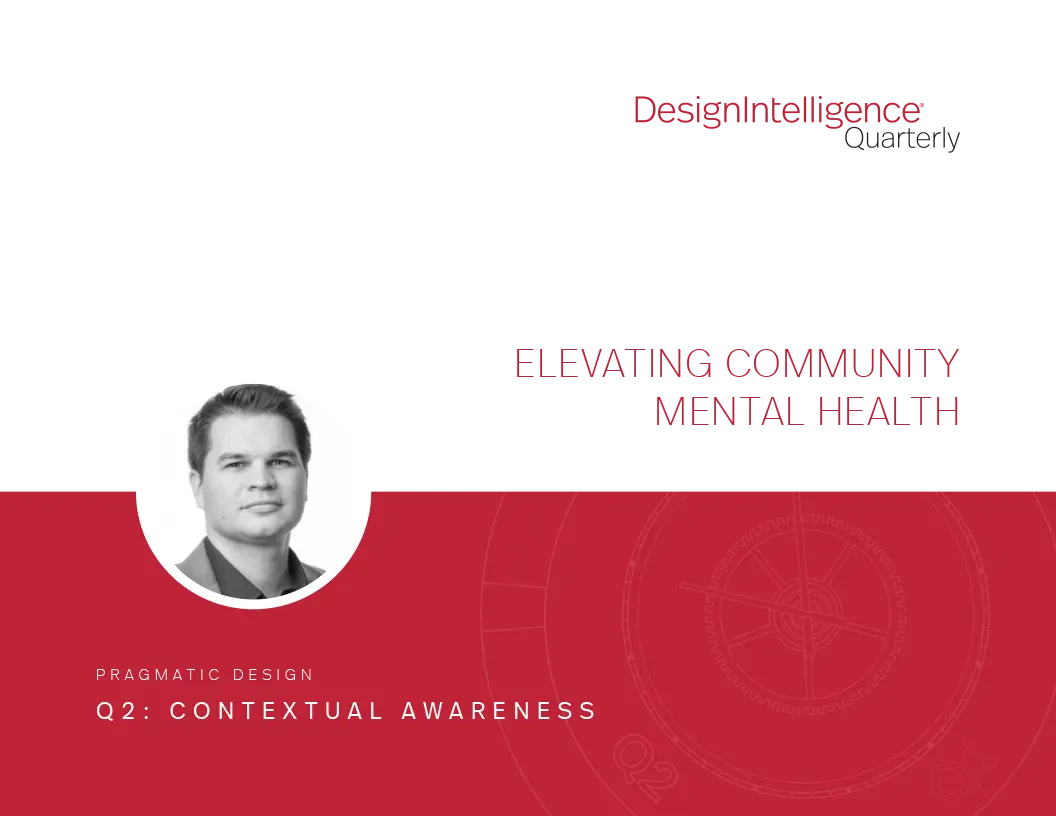When designing for humanity at its most vulnerable, those with the greatest interest in addressing mental health are often closest to its cause.
One degree of separation can be all that divides us from close friends and family struggling with mental health, addiction or both. As the child of a parent admitted to a behavioral health facility, this hits close to home. My namesake is a family member who lost his life to addiction. My godfather is a Vietnam veteran whose invisible war wounds resulted in extended stays with our family to help him get back on his feet. My graduate thesis in wounded warrior polytrauma care was informed by friends’ challenges returning from serving abroad.
Their stories of traumatic brain injuries and post-traumatic stress disorder(PTSD) gave purpose to my design research. This sense of purpose has driven my practice ever since. Once you truly understand that an individual’s crisis ripples outward into the lives of loved ones in unexpected and devastating ways, becoming an advocate for communities suffering in silence defines your design ideology and approach.
Systemic Challenges
As behavioral health planners, architects and designers, we would ideally position ourselves before clients with aspirations, not angst. Unfortunately, this is not always the case with mental health environments. Overburdened emergency departments (EDs), shortages of mental health beds and burnout of behavioral health staff all play a part. Every mental health provider we talk with hopes that patients never have to walk through their doors. Too often, we are called in to perform a facility risk assessment after a patient has tragically attempted to harm themselves or others. Such crises require us to design solutions to mitigate future tragedies. The most insightful design solutions for these community mental health facilities come when we collaborate empathetically with providers and their patients.
Contending with the deeply systemic challenges around mental health in North America brings to light many overlapping causes and effects that present themselves in each community differently. The increased societal awareness of mental well-being during the pandemic is the thinnest of silver linings. But this awareness is turning into action and is producing increased resources to turn the tide. Coupled with a wave of new funding and legislation, this sea change in thinking around mental health at the community level has accelerated development of new service models and facilities. This is especially true for the cultural contexts of communities, each requiring unique design solutions.
It is also why advocating for mental health through design has become more important. We are now elevating this discourse above the societal stigma associated with mental illness. This design advocacy is being codified by a few tenets coalesced around the notion of a boundaryless Behavioral Health Practice here at Stantec.
Dignity-Driven
As an overarching ethos to our boundaryless Behavioral Health Practice, dignity permeates all aspects of our design process. Acknowledging this need and our responsibility to provide for it helps planners, designers and engineers understand their roles in the continuum of care.
As a marked departure from the institutionalized settings of the past to more therapeutic healing environments, dignity is a concept that shapes a psychiatric facility’s “care culture.” Resulting design responses can foster cultures of safety, security and serenity for those in crisis, for visiting family or friends, and can support and lift up overburdened staff. Staff are safest when they know their patients and patients know them. Visitors are most comforted when spaces reflect the value of the relationships they seek to sustain with patients. Staff retention requires respite spaces with equal access to nature, sunlight and amenities that help them rest and recharge.
To promote staff safety, visitor comfort and patient recovery, the best therapeutic environments safely invite meaningful rapport and engagement between stakeholders. From socialization by choice to diverse therapy models, the built environment works better when the aspirational relationships between provider and patient are present throughout the design process and are embedded into the spaces. From addiction treatment centers that foster rehabilitation, to autism clinics that teach children how to navigate different sensory experiences, to behavioral health hospitals that use the built environment as a tool for self-regulation, design can promote dignity from form to finish. Thoughtful approaches to details and informed decisions can destigmatize by design.
A dignity-driven design approach seeks to humanize mental health environments for patients. It can also harmonize staff safety and enhance the comfort of visiting family and friends for the communities we serve. Through this lens we can better define our practice – a practice with purpose that advocates through design. Given the limited number of dedicated mental health designers in the field, it is important that we democratize mental health design strategies in the profession.
These values and foundational design ideas are best expressed through two project examples that address specific communities and their unique needs.

Veteran Mental Health: Winter Garden Photo courtesy: Stantec
“Crossing the Rubicon”: VAMC Puget Sound’s New Mental Health & Research Building
Seventeen. This stark statistic is the number of veterans that commit suicide each day on average, per the U.S. Veterans Administration’s (VA) own data. Recognizing and responding to the invisible wounds of war takes sustained comprehensive steps.
Sometimes the first of those steps can be the hardest. In Roman lore, crossing the Rubicon was seen as a significant step, a point of no return. This concept, “crossing the Rubicon,” was used as a defining inflection point for veterans seeking mental health services at the VAMC Puget Sound’s new Mental Health & Research Building. While it may be the hardest, this first step can be the most meaningful.
This new 220,000 square-foot facility strives to make that first step a little easier. In addition to providing valuable mental health and addiction services to a previously underserved community, the facility contains research labs in which scientists and medical professionals can learn more about how to better treat veterans.
The project’s building program includes outpatient services for homeless reintegration, addiction treatment, patient education and counseling, therapies and mental health services across the spectrum of care.
As the VA’s newest and largest dedicated mental health outpatient center, the building strives to adapt to diverse patient populations and
programs. From its front “Main Street” that organizes front of house access for veterans to secure corridors that allow after-hours
operations, the building adapts to user needs. After work or school programs available via an extended-access model can occur without the
need for extra staff given the project’s thoughtful and discrete entrances and perimeter
arrangements. Certain veteran populations, such as those seeking opiate substitute treatment, have dedicated entrances to cater to their
specific needs.
Based in the frequently overcast Pacific Northwest, the VAMC Puget Sound Mental Health & Research Building is organized around interior courtyards, exterior patios and internal gardens. These provide ample natural light throughout the building. This generous access to outdoor spaces, nature and social spaces throughout the building allows patients, providers and visitors to socialize or self-reflect as a matter of choice. Choice reinforces dignity by design and allows patients to decompress between group therapy or one-on-one consults. Providers can find respite areas to reset in dedicated outdoor spaces – more important than ever given the strains of high-touch mental health care services. Visitors and veterans alike can enjoy the stunning views of Puget Sound, which overlook Seattle and beyond. Evidence-based design principles teach that nature plays a key role in reducing stress, aid in healing and significantly shorten patient healing time.
In these ways, the VAMC Puget Sound Mental Health & Research Building is as adaptable and uplifting a design as are the patients’ stories of courage and recovery.
The Youth Crisis Stabilization Project
A staggering one-half of all emergency department visits for youth are mental health or addiction related.
Demand for crisis stabilization services is surging across communities in North America, especially regarding our youth. The second leading cause of death for young people is suicide. Stress and anxiety brought on by the pandemic, job loss, substance abuse and world events continue to impact people in profound and adverse ways. Emergency departments are crowded and ill-equipped to treat this vulnerable patient population segment. It is not uncommon to hear that a patient spent days in a small, 10’ x 10’ secure holding room with no access to daylight or nature. These inhumane, lackluster conditions only exacerbate individuals in crisis. Delayed treatment is further traumatizing.

Youth Crisis Stabilization: (Left) Outdoor courtyard rendering and (Right) interior living room milieu Photo courtesy: Stantec
Thankfully, health systems and public policymakers are responding to these trends. Government funding for treatment programs and medical research has increased in recent years, with billions allocated for such organizations as the the Substance Abuse and Mental Health Services Administration (SAMHSA). This has resulted in greater capital investment in behavioral health facilities by health systems nationwide. Even privately funded systems are investing deeply in the unique typology of crisis stabilization.
Since the mid-aughts, the “Alameda model” – which diverts mental health patients in crisis from overburdened emergency departments or ill-equipped law enforcement settings – has been deployed at various states across the country. This model has been further enhanced in recent years with the implementation of the EmPATH concept (emergency psychiatric assessment, treatment and healing). It creates something of a sub-typology that sits between the emergency departments and inpatient mental health services called crisis stabilization. By diverting medically stable patients in crisis, these high-functioning crisis stabilization centers can eliminate ED boarding as well as increase access to care while decreasing wait times, resulting in fewer inpatient admissions (up to 75%, per SAMHSA) while decreasing health costs overall. For the hardest hit rural and urban communities with the fewest resources, these crisis stabilization centers can be tailored to specific patient populations, such as youth or communities in the grips of the opioid addiction crisis.
In this regard, Stantec is on the forefront of designing behavioral and mental health facilities that overcome stigmas and challenge barriers to treatment and common socioeconomic factors such as poverty. We are currently prototyping a multistate crisis stabilization system designed with these ideals in mind for a specialty behavioral health provider. The increasing demand for patient-centered, cost-effective, empathetic care drives our behavioral health research and practice today.
This Youth Crisis Stabilization project is one such example for a client that gives patients choice in crafting their sensory environment. By giving patients control over full-spectrum lighting and other stimuli that can aid in self-regulation, patients are granted greater agency in their recovery process. An open observation area or “living room” allows patients to benefit from a therapeutic, social milieu that can aid in rapid assessment and recovery planning. Recent Facilities Guidelines Institute standards for behavioral health crisis units reflect this growing trend in the continuum of care.

Advocating Through Design: A Purpose for Us All
Our designers have been applying evidenced-based behavioral health practices that lead to better patient outcomes and shorter stay lengths for a range of community contexts. We believe design can support best practice medicine and help patients in crisis by creating calming environments that focus on de-escalation, not retraumatization. We employ dignity-driven, trauma-informed design principles that integrate experiential sensory considerations to create empathetic spaces for patients with a sense of dignity, respect, autonomy, safety and a connection to their community.
These are just a few examples of how we are crafting unique community solutions by consistently applying our design values and raising awareness of cultural contexts while elevating community needs and advocating for mental health through design. This builds upon our drive to craft a practice with purpose. A purpose we can all advocate for.
References
Trauma-Informed Care (traumapolicy.org)
The Alameda Model: An Effort Worth Emulating - PubMed (nih.gov)
Emergency psychiatric assessment, treatment, and healing (EmPATH) unit decreases hospital admission for patients presenting with suicidal ideation in rural America - PubMed (nih.gov)
Stephen Parker, AIA NCARB LEED AP ULI, is a behavioral health planner and architect with Stantec based in Washington, D.C. Designing mental health projects from the Arctic to Africa, Stephen is a proponent of “architect as advocate,” elevating mental health through design. He served as the youngest architect elected to the AIA Strategic Council and co-convener of the AIA Mental Health + Architecture Incubator. With recognition from organizations such as the AIA, Healthcare Facilities Symposium, NextCity, Fast Company Magazine, Healthcare Design Magazine & Engineering News-Record, Stephen is a collaborative researcher and accomplished designer. He serves as an associate director for the Design in Mental Health Network in the U.K., design chair for the DC Building Industry Association, a member of the ULI Health Leaders Network and a U.S. representative to the International Union of Architects’ Public Health Group. In his personal time, Stephen can be found building a three-generation home with his wife, Carrie, or volunteering abroad, most recently in Kenya and India as a medical planner, designing hospitals for local NGOs.


